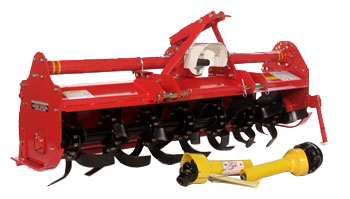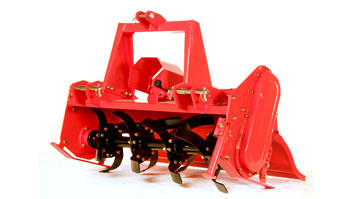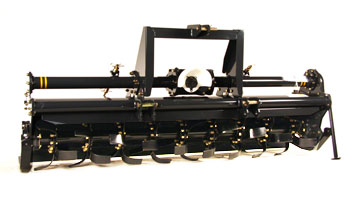
Power Tillers
Overview: Power Tillers also known as Tractor tillers are used though out the world preparing gardens and land for crops, controling weed growth. These power tillers are super effeicent and saves a lot of time from manuel labor. A power tiller is a spinning drum with a set of blades that are called tines that rotate with the drum while digging and mixing up the soil as it moves along. The tines on a power tiller can be different depending on the tiller however most have a bend that allows better digging and some even swing along the drum. Power tillers are available in a number of different widths to fit your tractors needs, as much as 80 inches if needed to get more done per pass.
Quality Built & Durable Components
Connected by a tractors 3 point receiver hitch and outside adjustable pin brackets simpliy offset operations allowing you to till closer to buildings or objects in the path. These tillers are built with reinforced steel frames and are built to last you a long time.
Power Safety
Includes PTO Shaft with a true helical gearbox and slip clutch portection the driveline component is safe from damage and over useage
Tractor Tiller Models
| Model | YJC 042 | YJC 048 | YJC 052 | YJC 062 | YJC 074 | |
|---|---|---|---|---|---|---|
| Recommended Tractor HP | 15-24 | 18-25 | 15-35 | 26-35 | 35-50 | |
| Tiller size | Length | 24.6 | 24.6 | 22.1 | 26 | 26 |
| Width | 46 | 51.6 | 57.3 | 66.2 | 77.9 | |
| Height | 32.3 | 32.3 | 31.9 | 33.5 | 33.5 | |
| Weight | 303 | 330 | 373 | 533 | 588 | |
| Tilling Width | 42 | 48 | 52 | 62 | 74 | |
| Tilling Depth(Max) | 6 1/2 | 6 1/2 | 6 1/2 | 8 | 8 | |
| No. of Flanges | 4 | 5 | 6 | 6 | 7 | |
| No. of Blades | 16 | 20 | 36 | 36 | 42 | |
| Hitch | Cat 0 & I | Cat 0 & I | Cat 0 & I | Cat I & II | Cat I & II | |
| Rotor Swing Diameter | 15.8 | 15.8 | 15.7 | 19.2 | 19.2 | |
Power Tiller Video
Video Transcription:
How To Till and Rotovate Your Garden With A Subcompact Tractor/Kubota BX
Okay, so this is the Everything Attachments tiller. That's what we brand it as. This is our house brand. It's actually made in South Korea by the company that builds the Ansung, so it's top quality tiller. It's everything. It's laser cut on it. It has the C-shaped tine instead of the L, and I've used them side by side before and a C-shape tine just simply cuts all the way through versus the L shape tine. The results are dramatically different. You can see it in one pass, that's why we've stuck with the C-shaped tine for what we wanted. These are extra heavy built. I did a video with this exact same tiller on my 23-horsepower Bobcat. It's actually a little bigger than a BX, but this has more horsepower. It actually loaded my BX pretty good on the horsepower end of it. Even though this tractor is smaller, it's got more PTO power. PTO power is what it's all about when it goes to turning these rotavators. We've adjusted everything on it to be pretty close to start out with.
It will hook up to a category two tractor, even on this little tractor if you wanted it to. And it does have these long pins in it, that if we wanted to, we could have actually put the lift arms even further on the inside, but on this case, we already had it adjusted for our other disc. This was the same dimension. That's why I really like a clevis hitch or an inside hitch for these inside stabilizers where I don't have to keep adjusting them every time. We've adjusted the top link down quite a bit where the slides are almost flat. The slides are adjusted all the way up. A tiller will basically, even though they're only meant to till this deep, if you go over it more than once, it will continue to drop but you shouldn't go past the center of the axle. The bigger the tiller, the bigger the whole rotating piece is, but the center line of the axle is about as deep as you should go on the tiller for a lot of reasons. So, we're going to give the other half of this garden that we didn't do with the disc a shot with the rotavator and see where we go from there. So just head down through there and start coming back and forth, and work that way.
The only thing I wanted to say is that on every tiller, because the gearbox is not far away like a Bush Hog and you've only got the distance between your lift arms and your PTO shaft, it's real critical on every tiller application, big or small, that you make sure your drive shaft, your PTO shaft, is the correct length. Now we've already cut this one so we know it's right for this BX. So just make sure that that's right, and if you let somebody borrow your tiller, you're taking a chance on it not being right for their tractor and damaging your own PTO. So just keep that in mind. What I usually do is I get it close, I cut the tractor off, hook the PTO up, and then back up and continue to hook up the three-point hitch because it's really, really tight in there on these little tractors. There's a couple other adjustments you ought to be aware of. If you don't want your ground really pulverized, then the best thing to do is raise this tailgate a little bit with your chain and that's going to keep it from being trapped in and recirculated so much. Now, on every tiller that I sell that's for Everything Attachments and anything that I recommend or I'm going to use, is definitely going to have a slip clutch on it because...this has been gone through. Most of the rocks have been gotten out of it. In most cases, they're not. You hit roots, rocks and different things, and you will be out here changing shear bolts all day if you have a shear bolt tiller.
Bush Hogs, you can usually get by with either unless they're really big. I like a slip clutch only, but on a tiller, I hate a shear pin and a slip clutch is the only way to go. But when you have a slip clutch, it takes up some space and you're on a short tractor with a short drive shaft, be really careful that you don't over cut. Cut twice if you have to to make sure you don't get your PTO too short from the top to bottom height, then it comes apart. Go ahead, Peanut. And what a tiller will do because they're pulling that weight, a tiller will actually try to push the tractor. So you can see it's doing, in one pass, about what the disc here does in two or three passes. So with the extra horsepower this BX has over my 23-horsepower Bobcat, it's not even phasing it, power-wise. And a tiller is never hard to pull because it's actually trying to push the tractor. So I've got the tailgate about where I like it, adjusted just far enough out there that it didn't pulverize it. It's letting it clear the stuff out of the back, but yet, it's still rubbing the ground and leaving a flat spot. If it's hitting anything hard there instead of having to change shear bolts, the clutch might be slipping a little bit, but it simply goes right back to working and you'll never know it.
So you do always goes slower with a tiller than you would with a disc. And that big clump of clay that's going over is taller than the tractor, but it's going to work. So you can hear the power of the tractor. It is pulling it down a little bit, but it's got plenty of power for that 52-inch tiller. This is a chain drive. We do offer gear drives. The facts of it are in the smaller tillers where you get a chatter going on...I like the chain, actually, better on anything less than 60 inches, for sure, than I do the gear because the gears are just not as large on a small tiller. A chain doesn't mind being slapped back and forth a little bit, meaning chatter, and gears don't like that at all. So with the bigger tillers where the gears are large, I like a gear-drive tiller just fine. I think it's the heavier way to go. But on the smaller ones, I personally prefer the chain drives and that's what this is. It has a chain drive on one side and a old bearing on the other side that is sealed to keep the dirt out. I've looked at a lot of tillers, and definitely, the Chinese tillers I'm not having any part of. There's some other tillers that are sold by Woods and Bush Hog and different companies that are American companies, but they're actually importing their tillers and the only thing about it is the decals being changed. So out of all of the tillers, I think the King Kutter we do sell. It is an American made frame. It uses all Chinese gearboxes. It's a good tiller. A lot of people really like them.
It does have the L-shape tine which I'm not a big fan of instead of the C-shaped tine, but it is an American-made tiller. I love that. But the facts of it are the Chinese gearboxes versus the South Korean gearboxes, and these have a spiral helical gear in it like a ring gear and pinion in a car instead of just cut beveled gears, and they simply will outlast them and outperform them. And the South Korean quality has come a long way. The Hyundai cars are everywhere, so are the Kias. And they've come a long way. The Chinese cars just never really made it because of the quality. See, he's on that ridge. That ridge is piled all the way up into the top and it's really taking a lot of power out of the tractor, but it's got it. So I'd go over the whole thing, start at this end one more time. Just go over the whole thing and we'll see how the total results are. So right now, I think you've got a pretty equal quality between one pass of a tiller and three passes with the disc harrow, and then we're going to go over it all, one more time. I think the tiller really helps do...that back tailgate. When that dirt's loose and that back tailgate gets a hold of it, it acts like a little bit of land grader. And it's not heavy but when the grounds that loose, it doesn't take much to leave it really nice and level. And we do offer reverse tine tillers, but the only thing I think a reverse tine tiller does better is something it's not even really even designed to do, and that's landscaping where it can actually get under the sod while it's pulling forward. Tillers are not really designed for that, but a lot of people do use them for that. Now, the only thing I have against backing up with a tiller, it isn't really going to hurt the tines, but if you catch that tailgate on that back edge and you've got a big enough tractor, you can back up and bend that tailgate.
Keep in mind that on the part that has been used with the disc harrow, that was with our very smallest disc harrow and of course, the bigger the disc harrow, the heavier the disc harrow, the better it's going to perform. But you're going to need a bigger tractor. It's starting to rain here a little bit in North Carolina, so hopefully we can finish this up pretty quick and come back and use the rest of these tools tomorrow. So he's going to give this a pass over where it's been disked already. And he doesn't realize it, but he's actually further over to the right than it's been plowed. So he's taken a little new ground to the right and some of the plowed ground to the left. That's why it's taking all the horsepower that tractor's got right now. So some people only use a tiller to make a garden. They don't plow and that's not what I recommend. Even though you do end up with six inches of loose soil and it plants well, it starts off the plants well, but when they get half season, it gets dry, that foot that you've got in-depth with the plow just makes all the difference in the world of where the rest of your crop goes from mid-summer on. Now, he's got that tiller buried right now, pulling all of the horsepower out of that little BX, which is doing an awesome job. So if a BX is what you have or if you're looking at buying a sub-compact, you sure have enough tractor to do just about anything you want to do. And we try to make the right grapples, plows, box blades and everything to fit these smaller tractors to do the same thing a big tractor can do, but on its own scale.
So that's one pass each way on top of the disked area. Let's go to the area that's just been plowed that hasn't had the disc on it at all. And it is going to take some extra passes since we didn't go over it with the disc harrow. But once you get through that first tough pass, everything gets easier. Every now and then, I can hear that slip clutch slipping when it hits something really stiff in there. Now he's back in the side that's only been plowed and gone through the tiller on one side, and that's a lot tougher area but it's doing well. And there's a big difference between that ground that's never been a garden for 20 years and that that has for six years. So every time you do it, it just gets better and better. So we've got our disc harrow hooked to the B over here. You've seen how that worked. You've seen how the tiller worked. You can make your comparison there. The one thing you can be assured of, the more you do it, the more your garden gets matured. And if you get it plowed in the fall and it freezes and thaws, the disc is going to do a lot better job. A bigger disc does an even better job, so we've got both on that. The plow's been used. You saw that worked a foot deep, no problem with either tractor. We've gone over it with a combination of the disc to see what it does, the tiller so you can judge that. We've got a garden bedder where we're going to heal for our squash and things like that that you don't want to get/stay wet after it rains and rot. We're going to go over it with a cultipacker just to show you what part of it would do if you were planting a food plot for the deer or something. We've got a set of pallet forks over here that'll go on the B because it has a quick attach on it to unload all of these attachments, is what we used it for off the trailer. We've got a larger garden bedder that we're going to use on the B. We're going to use the G50 on the BX, and we also have a 110 cultivator where we can cultivate the rows until they get about that high so all the packed down areas from the tractor tires and from you walking and so forth get loosened up and the nutrients and the water can get in the soil.
We'll be doing all of that hopefully tomorrow or the next day, depending on what the weather does. But for today, we know we've got rain coming in and this is about the end of it. So for today, we're done. Give us a call or an email at Everything Attachments. We can help you with any of your gardening or landscaping needs and help size the right attachment for your tractor and hopefully, the videos will help you know how to use and adjust your equipment. Thank you.
EA 52" Chain Drive Rotary Tiller

Features:
EA 42" Chain Drive Rotary Tiller

Features:
EA Heavy Duty Multi Speed 90" Tiller

Features:
Tractor Tiller Videos
If you are interested in buying a Tractor Tiller check out this great online selection of Tractor Tillers over at Everything Attachments